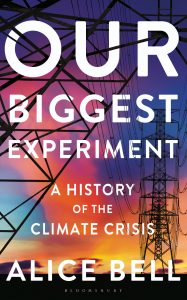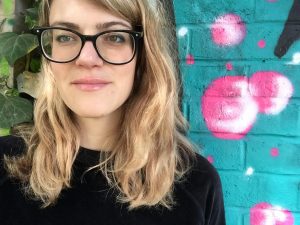 In Our Biggest Experiment, Alice Bell takes us back to explore the earliest signs and causes of climate change in the eighteenth and nineteenth centuries, to the advancing realisation that global warming was a significant problem in the 1950s and right up to today, where we have seen the growth of the environmental movement, climate scepticism and political responses like the UN climate talks.
In Our Biggest Experiment, Alice Bell takes us back to explore the earliest signs and causes of climate change in the eighteenth and nineteenth centuries, to the advancing realisation that global warming was a significant problem in the 1950s and right up to today, where we have seen the growth of the environmental movement, climate scepticism and political responses like the UN climate talks.
 Dr Alice Bell is a journalist and historian of science. Alice was a lecturer in science communication at Imperial College for several years, and was also a key contributor to the International Council for Science’s blog on climate policy in the run-up to the UN Paris talks. Alice has kindly agreed to answer some of our questions below.
Dr Alice Bell is a journalist and historian of science. Alice was a lecturer in science communication at Imperial College for several years, and was also a key contributor to the International Council for Science’s blog on climate policy in the run-up to the UN Paris talks. Alice has kindly agreed to answer some of our questions below.
1) ‘Our Biggest Experiment’ book reads like an epic story with so many interesting scientists and interwoven narratives. Was it always your intention to write this as an historical story, rather than a data and statistics driven text?
Totally. There are already loads of brilliant books explaining the science of climate change. I wanted to offer something a bit different.
When I started seriously reading up on climate change a little over a decade ago, I read through all the papers and briefings on the science and, crucial as all this info was, I kept finding myself asking questions about where the data came from – who commissioned it, why, when, how did they feel about that? This is partly because my undergrad degree is in history of science and I usually respond to science with questions about the people behind it, but it was also because I felt like I needed this history to really understand the climate crisis. As I read further and found answers to my questions. I learnt whole new sides to the climate crisis, deep back-stories and fascinating characters. I found it gave me a new perspective on the issue, and even lifted my spirits in places. I figured these were stories worth sharing, hence the book.
The numbers are vital to understanding climate change – indeed, chunks of my book are about how we came to start counting things like temperature and CO2 – but they’re only part of the story. If we really want to understand the climate crisis, we’re going to have to look around and behind the numbers too.
2) In the book you cover a number of different scientific disciplines and discoveries, which was your favourite area to research and why?
Science-wise, my favourite is probably the ways in which people started to unravel knowledge about past climates through cores of sea mud and ice. I loved reading the autobiography of Danish meteorologist Willi Dansgaard and his trips in the 1950s and 1960s to the Arctic, hunting bubbles of air trapped deep in ancient ice, taking them home for analysis. His study of cores from a US Army centre in the Arctic, Camp Century, took our understanding of atmospheric carbon dioxide back 100,000 years, helping scientists in the 1970s establish that the climate change we were living through was very much something they dubbed “global warming”, not cooling. I find paleoclimatology so wondrous, the ways people can piece together a history of the planet chasing markers through ice, mud, coral and tree rings.
It was also really interesting to learn more about the way scientists have contributed to the oil industry. From Yale chemist Benjamin Silliman Jr’s report on Pennsylvanian ‘rock oil’ back in 1855 (which arguably launched the American oil industry) diversifying into geology, engineering, oceanography and, when it suited them, atmospheric physics. Sometimes fossil fuel companies and their defenders get painted as “anti-science”. In truth they run on science, and always have done (they are just highly strategic about which bits of it they use).
3) I found it really interesting to learn about Eunice Foote and her role in discovering the greenhouse effect, especially since her contribution was overlooked or simply forgotten for so many years. Do you have a favourite character you discovered whilst writing this book?
It has to be Ida Tarbell, the journalist who brought down Rockafeller and the oil industry, over a hundred years ago.
Tarbell was born the same decade as the oil industry (the 1850s) in the same state (Pennsylvania). She saw the boom and bust of its early years, including the steady, steely growth of Rockefeller’s Standard Oil. She started off as a teacher, but moved to Paris in her mid 30s to write a biography of a female French revolutionary she thought had been overlooked, Madame Roland. She shared an apartment there with other women writers, hanging out with Louis Pasteur, Emile Zola and an Egyptian prince. While in Paris, she started writing for McClure’s Magazine, a literary and political monthly, first in pages previously filled by children’s author Frances Hodgson Burnett and later, once she’d moved back to New York, taking up an editorial post.
Tarbell apparently convinced the magazine’s owner, Samuel Sidney McClure, to run an exposé on Rockefeller and Standard Oil during a mudbath at a spa in Italy. Her father pleaded with her to pick any other topic for a story on monopolies than Standard Oil – he’d worked in the oil industry and knew you couldn’t win against Rockefeller. At a party in DC hosted by Alexander Graham Bell, one of Rockefeller’s bankers took her aside to say similar, adding a threat to the finances of the mag for good measure. She curtly replied this made no difference to her – she was a journalist, not the owner. Via Mark Twain, Tarbell bagged an introduction to one of the Standard Oil directors, Henry H. Rogers, who remembered her father and was surprisingly candid. Tarbell sleuthed her way to more and soon had enough to go public.
It was published as a series, starting in Nov 1902 and was immediately explosive. The publicity, in turn, brought her new stories, and the series ended up running for two years, published as a book in 1904, followed the following year with a biography of Rockefeller. The reporting influenced the 1904 election, and at one point Roosevelt found himself promising to return $100k in campaign contributions from Standard Oil directors. Then, in 1906, the company was told it had three years to divide itself up into smaller entities. The largest of these new smaller entities was Standard Oil of New Jersey, which we today know as Exxon. The New York arm we now know as Mobil, the Californian one became Chevron.
4) Your background is very well rooted in science communication – do you have any key tips for communicating climate change and inspiring change?
Anyone who says they know how to communicate climate change is selling magic beans. Climate is such a big, complex issue, a lot of the best advice goes out the window, or at least general sci comms advice isn’t enough. There are some basic good tips that apply to most comms work – think about the audiences you want to talk to, go to where they are already (e.g. don’t expect to talk to people who don’t like science at the Science Museum), and most of all, listen to them. But that’ll only get you so far. At Possible – the climate charity I co-run – we spend a lot of time pouring over any research we can get our hands on, so we can be as evidence-based as possible. There isn’t nearly enough research on climate comms, projects like the Centre for Climate Change and Social Transformations at Cardiff Uni is brilliant, but we need way more research funding on this issue. Something else we’re big on at Possible is finding ways to involve people in climate action – you can spend ages polishing your messages, but it’s all too easy for them to simply wash over people if there isn’t a way for them to get involved.
5) I felt a sense of positivity running through this book, reading about the scientific discoveries made over the years and the amazing technology mankind has developed. Do you find it easy to find courage amongst the bad news, and what makes you feel positive about the future of the climate crisis at the moment?
I’m really lucky to work at a climate action charity, it’s very different from reading data on sea ice melt day in day out. So when all the stories of climate impacts start to feel a bit much, I look to my colleagues taking positive, practical action and it helps me remember that there is still so much we can do. As the ever-articulate NASA climate scientist Kate Marvel puts it, ‘Climate change isn’t a cliff we fall off, but a slope we slide down.’ That slope is getting very steep, but we haven’t fallen off yet. There’s still so much of the world we can save.
There were times writing the book when I felt pretty down. There was a week last summer where it was just blisteringly, stiflingly, oppressively hot in London. London’s horrible when it gets too hot anyway, but that extra knowledge that climate change is contributing to the heat, and hurting people in other countries so much more, makes it all the harder. I was trying to finish the first draft of my book and re-reading all these papers from the 1960s or 1970s musing that “if” we didn’t do anything, the climate could get nasty after the year 2000. It made me so angry about all those lost years of delay and inaction. But at the same time, writing the book helped me find strength too, especially the stories of scientist’s research. Because climate change isn’t obvious. You need science to see it. We could, all too easily, be sitting around thinking ‘the weather’s a bit weird today. Again.’ We at least have this warning, and that’s something quite powerful in itself, even if we haven’t been fast enough to take that warning.
6) Do you have any further projects or books in the pipeline you can tell us about?
I have started mulling over an idea for another book, but honestly I’m not sure I have time. I’ve got too many exciting projects at Possible. My colleague Neil has some amazing work brewing on community hedge planting which has to be put on hold with the pandemic, but I’m so excited to get dug in (literally!) in the next planting season. Then another team member, Emma, has a really fun citizen science app we’re hoping to launch soon (if we can sort the bugs). Then there’s our solar railways work, projects listening to communities about what they think about projects to curb traffic in towns which sprung up during lockdown, and of course the big UN climate talks in Glasgow in November. One thing about climate campaigning is there’s always more to do! It doesn’t get boring.
 Our Biggest Experiment: A History of the Climate Crisis
Our Biggest Experiment: A History of the Climate Crisis
By: Alice Bell
Hardback | June 2021| £16.99 £19.99
All prices correct at the time of this article’s publication.
